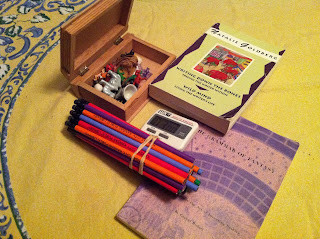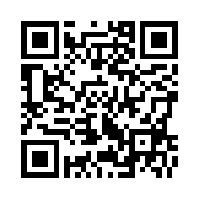Sometimes other storytellers ask me how I can give workshop plans away like this. I remember what Eric Booth says in
: 80% of what you teach is who you are. If somebody takes my workshop outline and puts it into practice, it will be completely different from what I do. Maybe better!
 |
| Stuff I use, sometimes, for "Storytelling, storywriting" |
Back to the workshop. This is an adaptable program. I can do a 45-minute version, a 90-minute version, a two-hour in one fell swoop version, or a multiple day version. It works best with grade 4 (age 9) and up, with kids who can read out loud fluently. I've done it in Mexico with kids from all over the country who study at English schools, in
Salina, KS with fourth and fifth graders, at a
Juvenile Detention Center.
In the best case scenario, I have a whole session of storytelling before we even get to the writing. That's what will happen next week in Salina when I work with fifth graders. I'll tell mostly stories I wrote, pointing out story structure and the way descriptions in the stories evoke the senses. We'll have time for questions about stories and storytelling. The kids usually feel comfortable with me by the end of the session. That's intentional. I need to connect with them for this to work.
In the second session, I read a story out loud. I like "The Big Stone," which can be found in
The Guizer by Alan Garner. It's written in a slightly archaic style, and though I read with expression, the students glaze over. Then I tell it the way it is on my CD
The ghost with the one black eye, to demonstrate the difference between a written and a told story.
I ask what they notice, reminding them that there is no way they can be wrong in what they say. We talk about the use of gestures, facial expressions, the voice and the body. We might do an exercise or two to underline this.
Then, using a different story, we work on backstory. I want them to understand that in order to tell a story well, I have to see it fully. I must be able to answer any question they might ask me about any character, setting, or bit of action in the story, spoken or unspoken. The color of the big sister's shoelaces in
The ghost with the one black eye? Pink, absolutely. Is there a pet in that story? Yes, a big dog. (Note: if I get in a rut with a story, sometimes I change the picture in my head)
Then what? We move on to writing. I use an abridged version of
Natalie Goldberg's list of rules for writing practice from her fabulous book
Wild Mind. I insist that the kids write them down so these rules will go in their pencil hands to their brains. Then, using the rules, we write for three minutes on a topic I give them. As they write, the room is absolutely silent. Occasionally I prod them with a reminder to keep their hands moving, or I give a slight suggestion if they think they're really stuck. After the timer goes off, we read a few aloud.
Then we play a game I adapted from
Gianni Rodari. It's like
"Heads, Bodies and Legs," which I've just learned is also called "Le cadavre exquis," or "Exquisite corpse," but with writing. Here's how I described it in
a post in 2008:
It's a game where we write a story line by line, folding the page backwards after each line and then passing that paper to the next person. I prompt the kids for each line: "Who was it?", "Where was he/she?", "What did he/she do?" and so on until the story is done. After each line, the paper is passed to the next kid. They're not supposed to look at the previous lines, so when the paper is unfolded, it's a completely ridiculous story. Some of them make a strange kind of sense.
It's a great game to teach story structure. I also point out this even simpler story structure:
Somebody wanted...
But...
So...
If there's time, we extend the timed writings or the game, or we can add another game, either a storytelling game or a writing game. Even as I'm going out the door, the students often are asking if they can do this some more. They're having a blast writing and storytelling!
Did I ever mention how much I love what I do?









